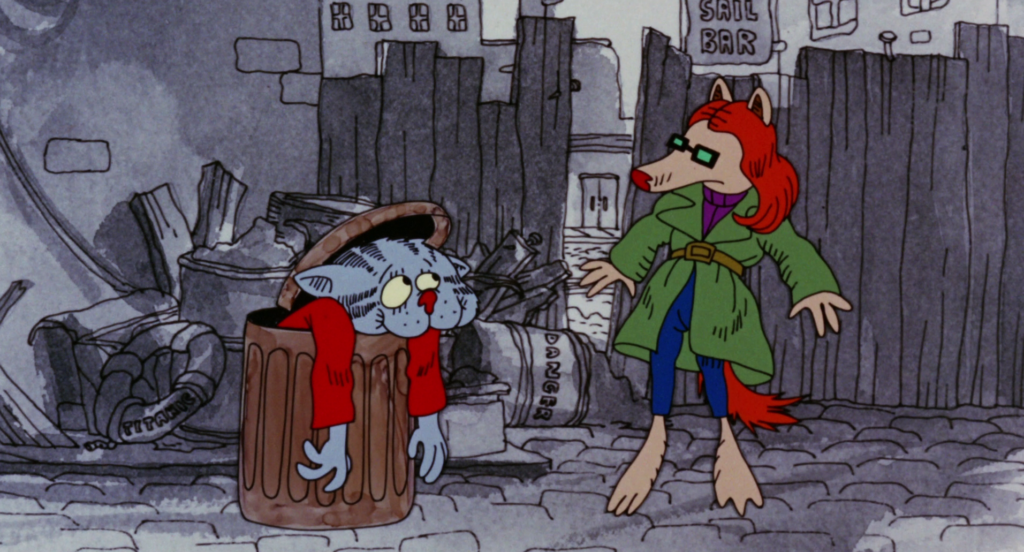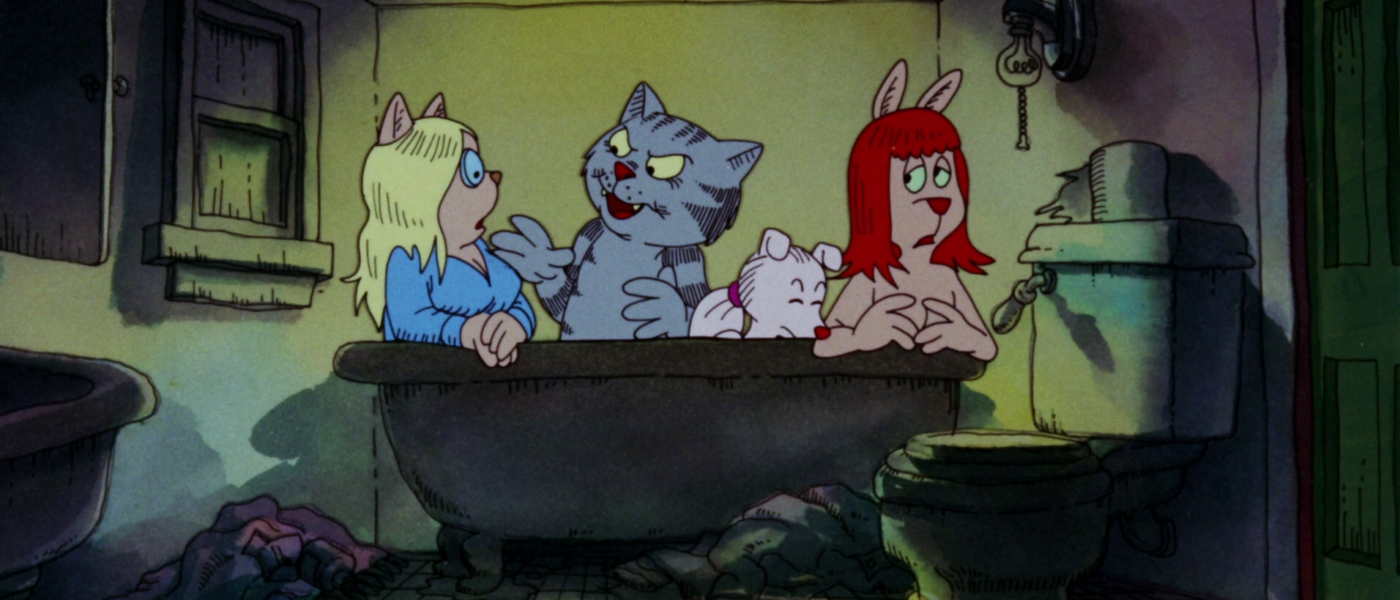Ralph Bakshi Pushes Boundaries in Landmark X-Rated and Animated Debut
DIRECTED BY: RALPH BAKSHI/1972
BLU-RAY STREET DATE: OCTOBER 26, 2021/KL STUDIO CLASSICS
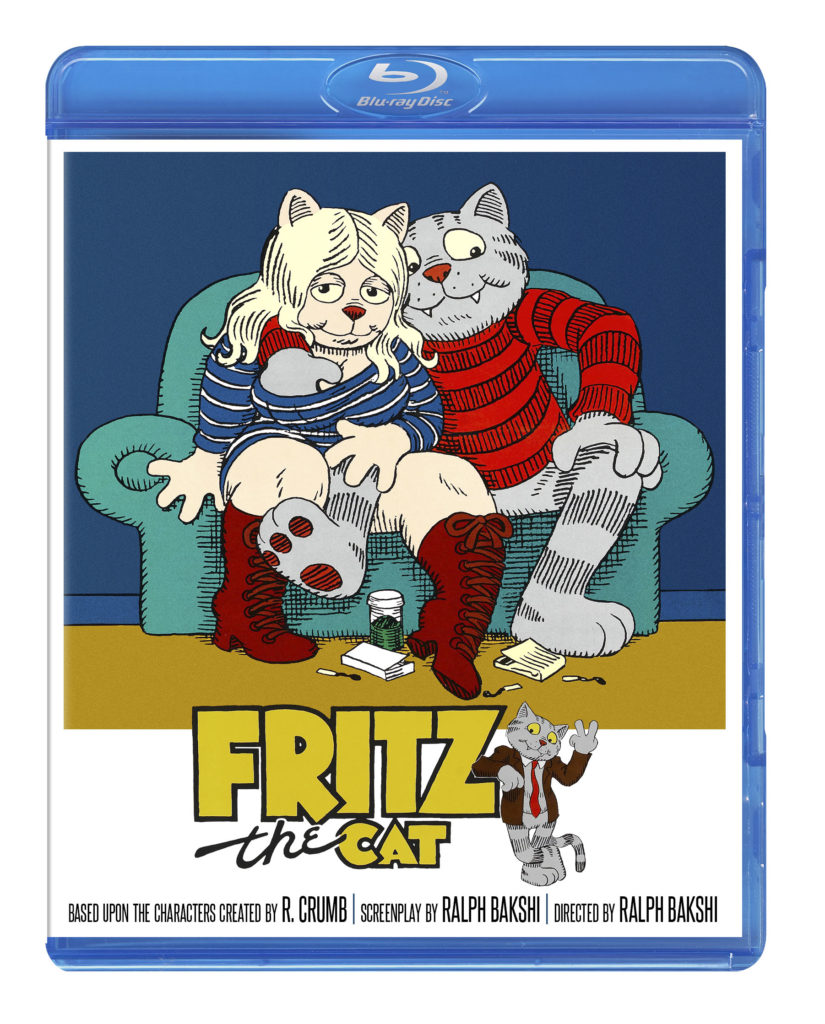
Funny Animals partake in erotic escapades, crows and cats smoking up and screwing as NYU burns. Nazi cultists plot terrorist bombings while overzealous cops beat rioters into submission in Harlem. Fritz the Cat is a wild and wonderful trip, for sure, but it’s far more than just a showcase of cartoon debauchery.
Fritz the Cat makes its long awaited Blu-Ray debut courtesy of Kino Lorber Studio Classics and Scorpion Releasing. The 1972 film is not the first animated feature targeted at adults – predated by Mushi Productions’ A Thousand & One Nights (1969) and Cleopatra (1970) – but it is without question the most significant. While those previous films would incorporate adult elements into the more commonly animated fairy tale and literary adaptations, Fritz the Cat is a true product of underground cartooning and the New Hollywood era. Adapted from the comic by underground pioneer R. Crumb –to his endless chagrin – by then up-and-coming director Ralph Bakshi, Fritz the Cat is an urban, contemporary story.
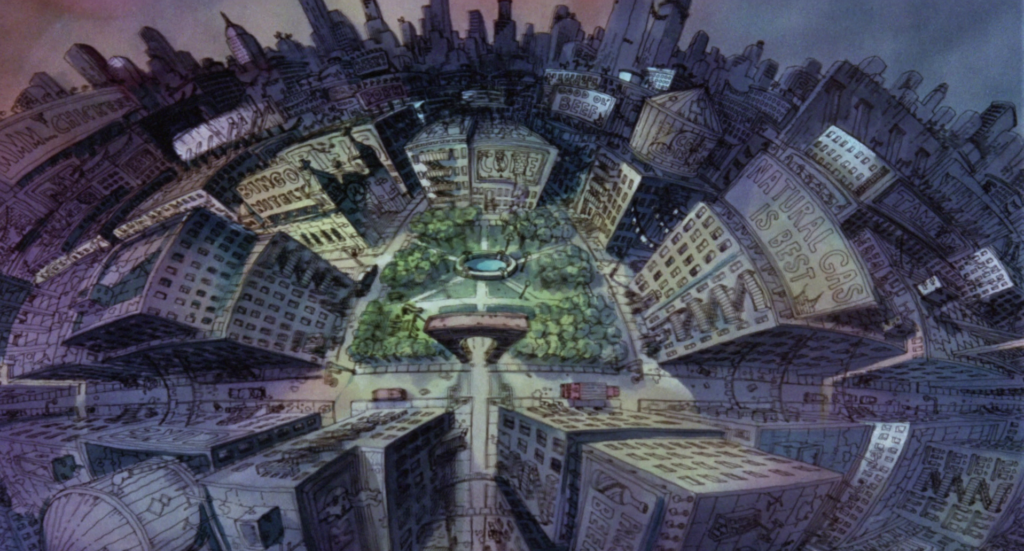
Combining Crumb’s character and stories with elements of Bakshi’s own life and urban upbringing, Fritz addresses all manner of taboo subject matter, all played out by a dissonant Funny Animals cast. While uneven, suffering from clunky episodic storyline that rarely transitions terribly well from vignette to vignette, Fritz possesses a poetic sensibility and compelling ideas that pair nicely its eclectic cast of all-too-human animals. That thematic content, while weighed down by Bakshi’s off-putting handling of his female cast and some unfortunate decisions in presentation, often feel just as relevant today as they were in 1972, if not more so. Its visual design and animation are crude, but compensated by the bold and often more interesting shot composition, in conjunction with a unique presentation of dialogue in an animated film. All this presented in fabulous high definition for the first time courtesy of Kino Lorber and Scorpion, with some compelling extras for Fritz fans to dig into.
Fritz the Cat opens on a title card, letting the audience know that the film takes place in the 60s, one which makes Fritz a period piece even in the 70s. Following a brief interlude with some construction workers, we’re introduced to the eponymous Fritz, a yuppie hipster college student with delusions of grandeur as he and some friends try to woo a trio of young women. After his friends give up on the pursuit, Fritz manages to bait the women into following him to a friends’ apartment through phony promises of spiritual enlightenment, culminating in an orgy in a rundown restroom. The celebration of free love is interrupted by pair of police officers – literal pigs – who brutalize the participants and chase the errant Fritz, who end up chasing him through a Synagogue before he manages to escape. Returning to college, Fritz finds himself disenchanted with higher education, going a long screed about his distaste for the establishment before lighting his notes on fire, an act he immediately regrets and which results in NYU burning to the ground.
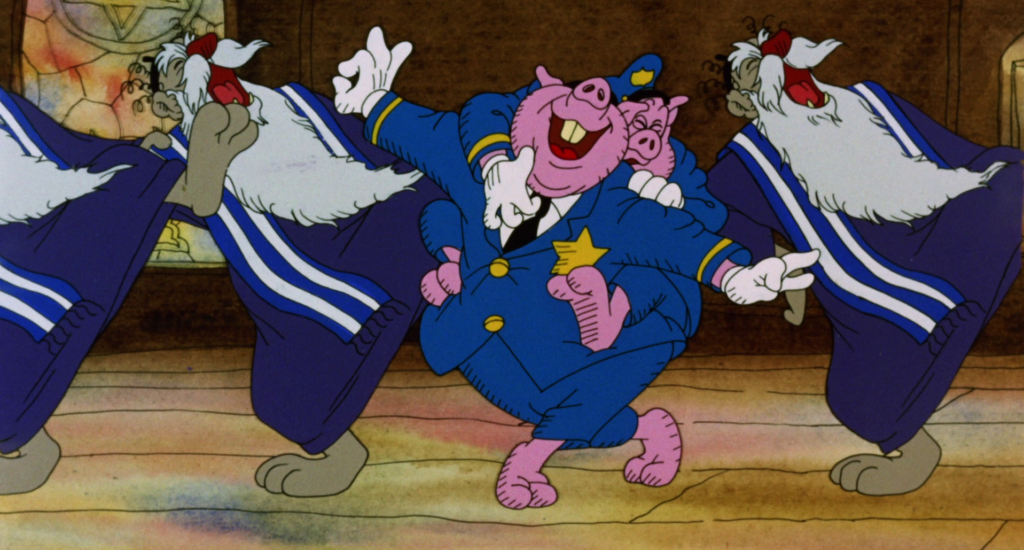
In a state of ennui with his life, Fritz heads to Harlem and hits up a bar populated by crows – the film’s analog for black people – and after making a fool of himself multiple times manages to find a friends in a pool playing crow named Duke. Leaving the establishment after Fritz elicits the ire of the bartender by calling him “boy”, the pair steal a car and Fritz takes them on a wild joyride, nearly killing them both. That episode behind them, they arrive at the estate of Duke’s drug dealing friend, and Fritz is seduced by the crow Bertha after she indulges him with numerous joints. In the post-coital haze, Fritz feels that he’s awoken to some level of class consciousness, and rushes to the street to proselytize the tyranny of the bourgeoisie to the crows. Things quickly go out of hand as Fritz directs the ire of the crows towards the same pair of cops that chased him earlier, resulting in them firing on the crowd who respond in kind. The violence escalates as a riot breaks out, Duke desperately pleading for Fritz to calm down before being gunned down in the crossfire. Fritz, suddenly very aware of the violence around him, flees the encroaching riot police and incoming air raid by the US Military, taking cover in a garbage can as Harlem is devastated.
In the aftermath, Fritz is found by his girlfriend, the level-headed Winston Schwartz. Unrepentant but now a fugitive, Fritz and Winston flee the city to find a new life out west, only to spend much of the trip bickering with one another. After Winston’s car breaks down and the two’s differences come to a head, Fritz wanders into the desert, where he encounters the neo-Nazi, heroin-addict rabbit biker Blue and his girlfriend Harriet. Hitching a ride with the unhappy couple, Blue brings Fritz to the headquarters of a fascist, terrorist cult, where he is forcibly inducted and sent on a suicide mission to detonate an oil refinery, leading into the film’s explosive finale.
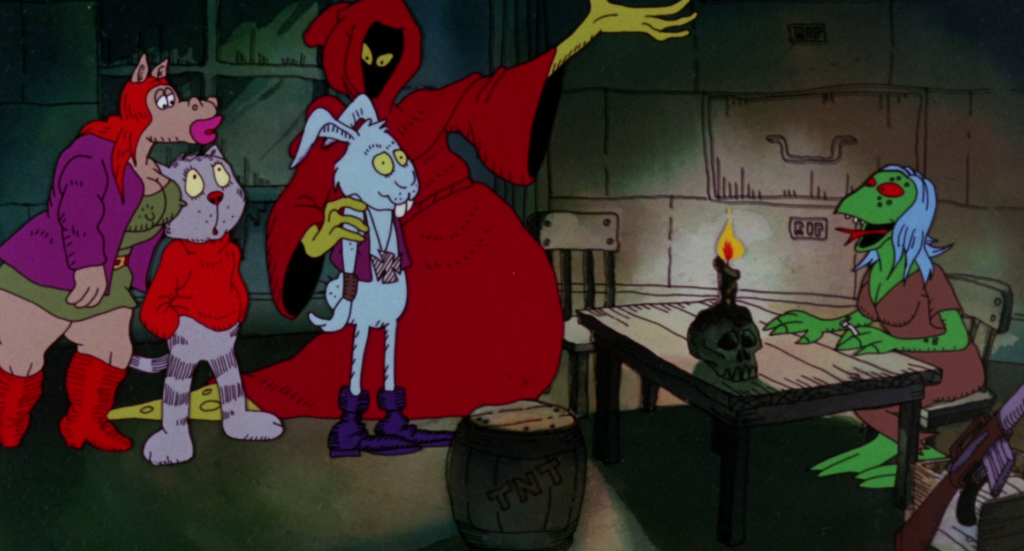
Fritz resists a concise summary. It is composed of a variety of episodes and little vignettes, with little true through line outside of Fritz’s nebulous quest for enlightenment. While some of these vignettes transition more naturally, a few employing wonderful stylistic sequences like the “Bo Diddly” number and Fritz and Winston’s flight from the city, many aren’t quite so seamless. Particularly, the film loses a lot of forward momentum in the last 25 minutes following the Riot in Harlem. The epilogue is easily the weakest part of the film as well, undercutting much of the messaging and reading as a compromise by Bakshi to not have a “downer ending”, instead indulging in the sort of puerile, vapid horniness that it had largely managed to avoid.
Despite those hiccups, Fritz is still quite a bit of fun. Upon revisiting it for this review, I was surprised at how much subtle, dry humor was included in the dialogue, and it often manages to be quite funny. The more crass elements, the sexual elements especially, are never terribly funny and certainly never achieve – nor do they really aim for – anything erotic, but come across very much as creatives exploring this new space of adult animated content in a way that’s oddly compelling in its own right. Fritz himself isn’t terribly likable, but perhaps more pitiful through much of the film. He’s a neurotic, insecure, self-obsessed hipster that tries constantly to be cool, but typically only manages to humiliate himself in some way. Those times he manages to succeed are often weaker parts of the film, but are thankfully few and far between. The treatment of women by the film is frustrating, thinly characterized and typically framed exclusively in their relationship to men in the story, on top of being typically some combination of vapid, scheming, shrewish, and monstrous. However, while still a noticeable issue, Bakshi does at least offer a more engaging examination of another minority group.
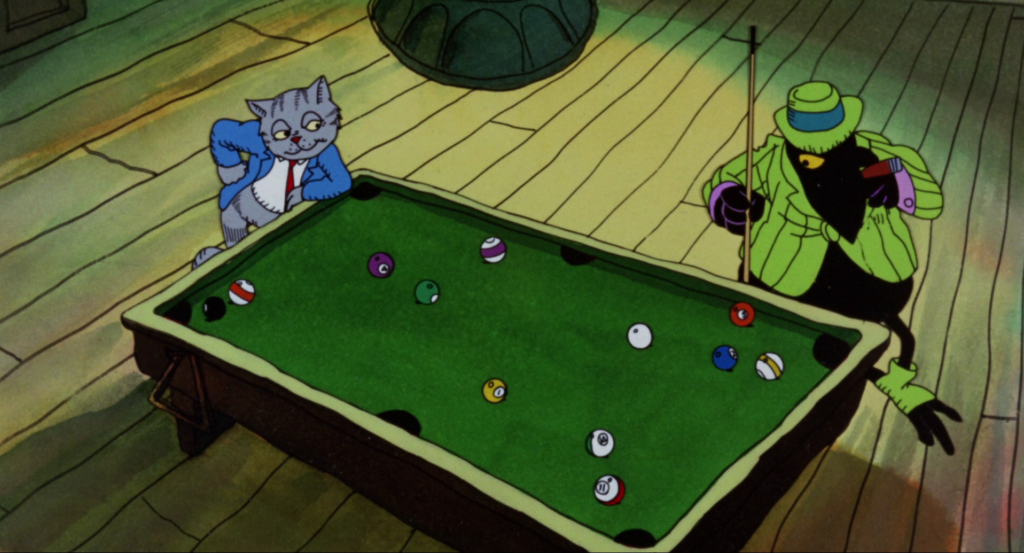
Bakshi’s handling of race in Fritz the Cat is a harbinger of more compelling ideas in succeeding films like Heavy Traffic (1973)and Coonskin (1975), but often work quite well here. The crows are frequently the most sympathetic characters, with Duke’s death being the single greatest moment of pathos in the film and an incredibly artfully rendered sequence. While one can definitely argue if it was Bakshi’s place to try and re-appropriate the iconography of the crow, there is a sense of authenticity and genuine sympathy in his depiction that at the very least makes things more palatable. The Riot sequence especially, bringing to life Martin Luther King Jr.’s statement “A riot if the language of the unheard,” as the ghettoized crows strike back against the tools of violent authority weld by the government, only to be met in kind with overwhelming violence by the United States government in response. It is a depiction which does not seek to condescend to a black audience, but uses the medium of animation and convey a pointed and direct critique of the US’s response to civil unrest, particularly from minority communities.
Animation in Fritz is mixed, certainly. At times Fritz is able to move in three-dimensional space effectively, staying on model and retaining a sense of weight, while in others he sloppily squashes and stretches along. The rest of the cast fairs no better, with some movements being quite fluid but a lot being just competent, and a few being noticeably poor. However, the decision to use hatching lines for shading and for Fritz’s stripes is impressive, and complements the graphic sensibility of the film, despite some inconsistencies that crop up from its usage. Most compelling are those shots that employ more dynamic composition, with scenes like Blue’s morning routine and the Riot deviating from the flat, TV animation framing much of the film employs. However, for what Fritz lacks in animation, it makes up for in its presentation.
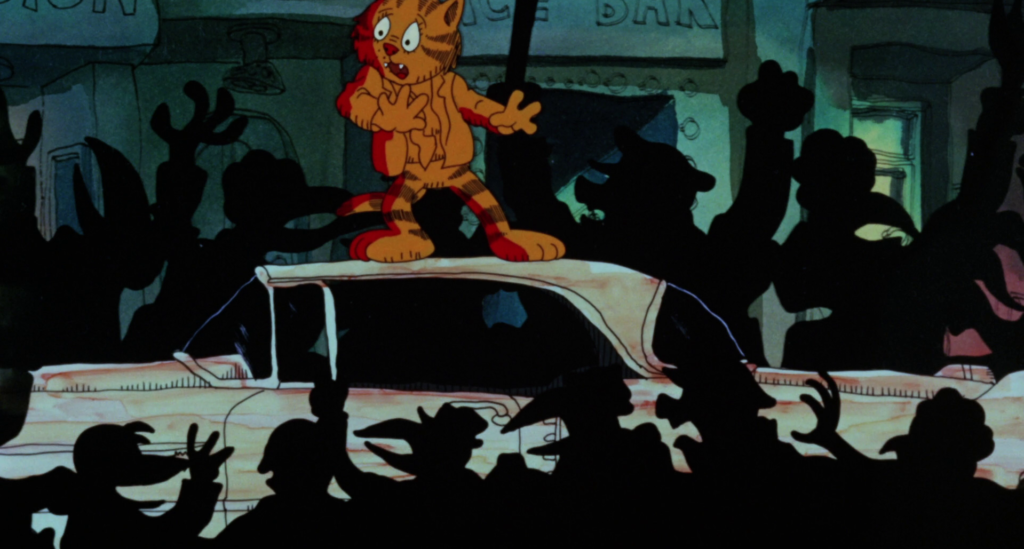
Presentation in Fritz is mixed, but even when bad it is at the very least compelling and distinct. The backgrounds, created by Ira Turek and Johnnie Vita, are gorgeous. Traced from photographs and featuring vivid watercolors, frequently employing distorted perspective and slightly uneven linework, they add a sense of irreality to the film and compliment the underground cartoon aesthetic, with Turek even employing the same Rapidograph pen Crumb employed when drawing his comics. The use of poetic visual metaphor as well is a wonderfully distinctive addition, with the handling of Duke’s death, each fading heartbeat accompanies by a pool ball being pocketed, standing out chiefly among them. Certainly, later Bakshi films would employ these visuals more frequently, but what’s here is an excellent start and adds a great deal to the film.
Dialogue in Fritz is another key element which enhances its presentation. Much of it is performed naturalistically, with characters interjecting and cutting one another off in a way that distances it from the stageplay presentation of most previous animated works. While something vaguely similar was employed in the old Fleischer Popeye shorts, it never really added to the sense of reality, whereas in Fritz it creates an effect that more closely aligns with how dialogue was presented in the films of the New Hollywood-era. Going one step beyond, Bakshi actually interviewed people on the streets, animating a handful of these stories and conversations in a fashion that not only enhances the overall flavor of Fritz, but offers a sense of grounding that counters the more wild antics.
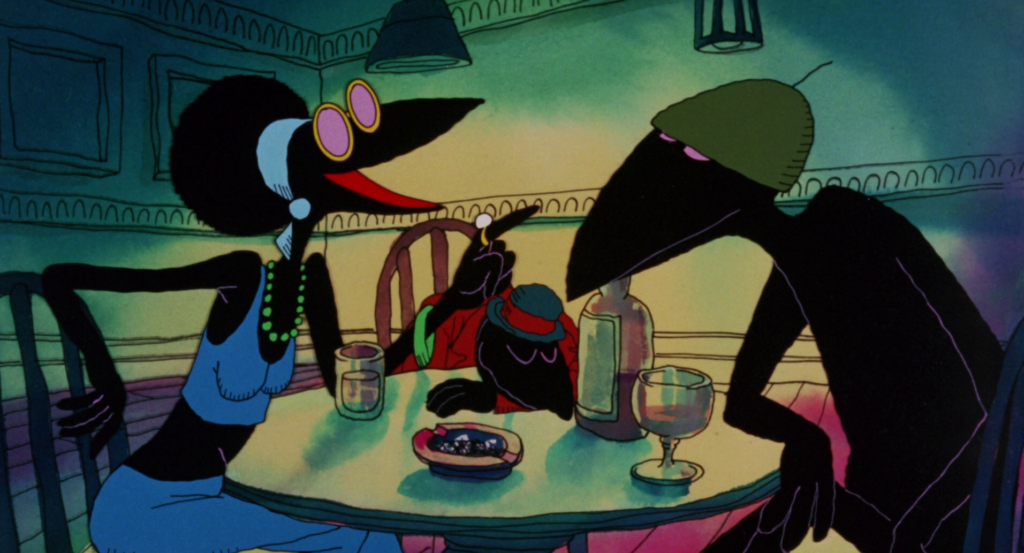
Further enhancing Fritz’s soundscape is the spectacular soundtrack and score. The variety of vocal tracks by acts like Charles Earland, Billie Holiday, and Bo Didley are frequently employed to help smooth out the transitions between sequences, and do so effectively, adding to the almost nostalgic sensibility the film possesses. The score by Ed Bogas and Ray Shanklin includes a few new vocal tracks, with an effective and off-kilter theme for Fritz and an enjoyable if inexplicable theme for Winston. The rest of the score is a good mix of enjoyably jazzy and funky, certainly fitting, with “The Riot” serving as the standout piece of background music.
The film’s Blu-Ray release is excellent, and an upgrade from the old DVD release in every way. Fritz has never looked better, and the restoration is absolutely gorgeous, striking a perfect balance between vibrancy and clarity of picture without aggressive grain scrubbing that muddies the details. The most notable extra feature is the included commentary by comics artist Stephen Bissette and author G. Michale Dobbs, which is strikes a pleasant balance between conversational, personal, and informative. There are a few minor factual errors, such as Dobbs ascribing Bakshi’s creation of the animated television The Mighty Heroes to his tenure at Paramount and not his time at Terrytoons, but these are rare and hardly harm one’s ability to enjoy the discussion. The two other features are a trailer and radio spot, nothing special but nice to have. English subtitles are also included for the deaf and hard of hearing; a minor thing, but the additional accessibility feature is certainly nice to have.
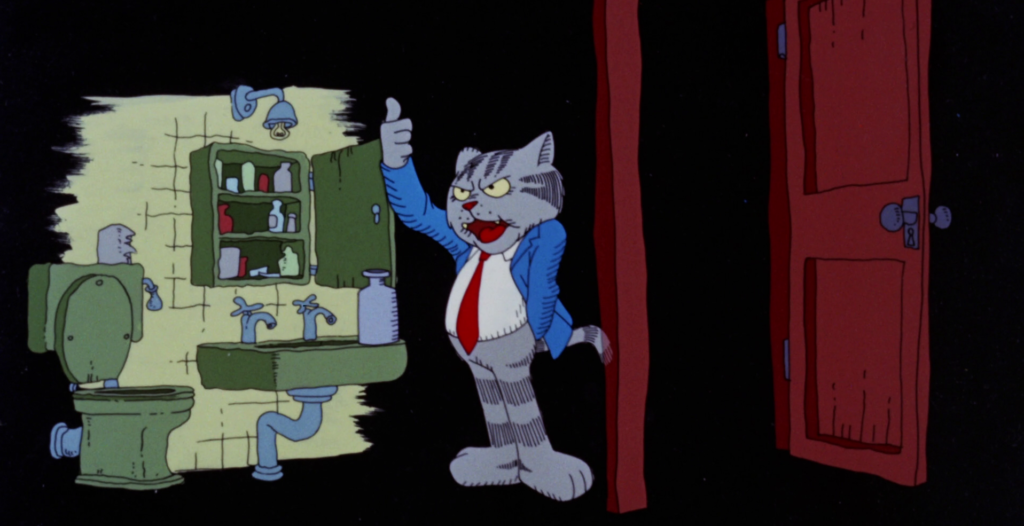
Fritz the Cat is a must-see for film and underground comics fans, and its Blu-Ray release is a must-have. Fritz certainly has its fair share of frustrations; its depiction of women, haphazard pacing, more hyperbolic moments of crassness, and weak spots of animation are issues that will negatively impact one’s ability to enjoy it. But the enjoyably dry humor, inventive visuals, unique presentation, and the continued novelty of an adult animated feature with Funny Animals characters are sure to entertain. And for those looking for deeper thematic substance, its addressing of the treatment of black communities, police brutality, and even white terrorism are prescient, more relevant know than they were at the film’s release, and demonstrating a depth and subtlety one would hardly expect from that picture about the horny cat. A fantastic film with a wonderful release that shouldn’t be skipped.
